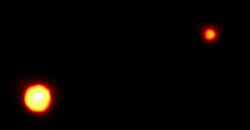Portal:Astronomia/Artykuł miesiąca 01 2010

Pluton (oznaczenie oficjalne: 134340 Pluton) - planeta karłowata, najjaśniejszy obiekt pasa Kuipera. Został odkryty w 1930 roku przez amerykańskiego astronoma Clyde'a Tombaugha. Od odkrycia do 24 sierpnia 2006 r. Pluton był uznawany za dziewiątą planetę Układu Słonecznego. Tego dnia astronomowie na Zgromadzeniu Ogólnym Międzynarodowej Unii Astronomicznej w Pradze odebrali Plutonowi status planety, co oznacza, że w Układzie Słonecznym jest teraz tylko 8 planet.
Pluton należy do szerszej grupy obiektów transneptunowych...
przeczytaj cały artykuł | poprzednie miesiące...
Media użyte na tej stronie
This is the clearest view yet (as of 1994) of the distant dwarf planet Pluto and its moon, Charon, as revealed by NASA's Hubble Space Telescope (HST). The image was taken by the European Space Agency's Faint Object Camera on February 21, 1994 when the planet was 2.6 billion miles (4.4 billion kilometers) from Earth; or nearly 30 times the separation between Earth and the Sun.
Hubble's corrected optics show the two objects as clearly separate and sharp disks. This now allows astronomers to measure directly (to within about 1 percent) Pluto's diameter of 1440 miles (2320 kilometers) and Charon's diameter of 790 miles (1270 kilometers). The Hubble observations show that Charon is bluer than Pluto. This means that both worlds have different surface composition and structure. A bright highlight on Pluto suggests it has a smoothly reflecting surface layer.
Though Pluto was discovered in 1930, Charon wasn't detected until 1978. That is because the moon is so close to Pluto that the two worlds are typically blurred together when viewed through ground-based telescopes. (If our moon were as close to Earth, it would be as big in the night sky as an apple held at arm's length). The new HST image was taken when Charon was near its maximum elongation from Pluto of 0.9 arc seconds. The two worlds are 12200 miles apart (19640 kilometers).